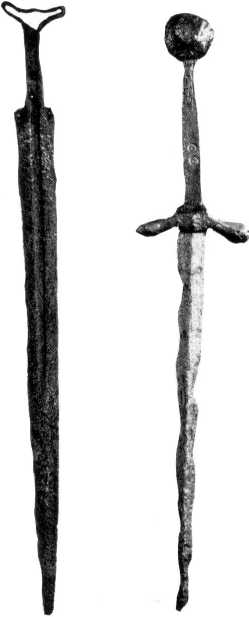m75#
Professional infantry. The total strength of the bodyguard was normally about 5000 men, but there was also a ‘Young Guard’ (known as the youths or sąuires of the Chamber) of about 500 youths ffom leading families, who were trained for military posts and had pledged to execute at once any command given them. Those who distin-guished themselves (and survived) rosę to the rank of amir. As in the Seljuk armies, each amir of notę also maintained his own smallcr bodyguard, which accompanied him in the field when he served the caliph.
The remainder of the army was recruited mainly from the Arabs, Bcrbers and Sudanese, but their military ąuality was generally inferior to that of the Seljuk and Frankish armies. The Sudanese fought on foot and provided the archer arm of the army; the Arabs and Berbers fought on horseback with lance and sword but relied on mobility and superior numbers for victory over the morę heavily armed Frankish knights. There were no mounted archers in the army, but from time to time, as politics dictated, contingents of allied Turks did sometimes join the army on campaign.
The Bedouin were also employed by the Fati-mids, filling the light-cavalry role. Bedouin society was patriarchal and the warriors were never ordered to do anything—they followed the example of the sheik voluntarily. This was not conducive to success in regular battle, and in generał the Bedouin were unreliable on the battlefield, liable to join the winning side at the last minutę in order to participate in the pillaging; nonetheless, they were employed extensively by all the Mosiem dynasties, as well as by the crusaders, in a reconnaissance role, and by the Moslems as light cavalry on the extreme Banks of armies in the field.
The army was supportcd by a system of terri-torial reservists similar to that of the Seljuks.
The amirs who provided the olficers for the army were of three classes: amirs of the gold chain, who commanded the various divisions; sword bearers, who escorted the caliph; and the lesser amirs who formed the chivalry of the army with the sąuires of the Chamber. The lighter armed Arab and Berber cavalry formed a second linę to the amirs and sąuires.
r

Left: a baselard-type knife, 27U1 overall and with a single edged blade. Centre: a double edged dagger with 3 iin blade. These weapons were little morę than short swords, and as such formed a secondary weapon for the crossbowmen and spearmen.
Right: a double-edged quillon dagger, i3.iin over-all, with a diamond section blade. This was the type carried by mounted men, usually at their right side, but was only used as a last resort.
V_J
THE AYYUBID ARMIES
When Saladin came to power in 1169 his first action was to crush a revolt of the Sudanese guards and to form an entirely new bodyguard, loyal to him, from about a thousand Kurdish free men from his own family’s retainers and from the 2000-strong askar of Shirkuh, which was serving under him in Egypt and which transferred its loyalty to him en masse. Saladin then began to rebuild the rest of the forces of Egypt into an elficient fighting machinę capable of hwading the Frankish States and reinstating Islam.
Wyszukiwarka
Podobne podstrony:
depression: the mcan yield was 7.1% of that in Slerilizccj soil. The yield of Lotus pedunculatus was
The group was also remarkable for the number of its members whose works would claim a permanent plac
76 Tomasz Sobestianczyk "The total cost of ownership of IT assets is reduced cm average of $761
2013 Editor: KAŹMIERCZAK). The average length of professional experience of the respondents was 12,7
9) Jasieńko J., Raszczuk K. (2011) Strengthening of the rotating dome in latitudin
MEDCOM has developed and supplied compact, lightweight inverters of the total power of 2000 kW for t
177STRUTS Investigation of the compressive strength of spruce struts of rectungul&r cross sectio
191 TUBES The Crinkling strength and bending strength of round aircraft tubing, by W.R. Osgood. Wash
2- 265 Bcvan) said about the strength of thc German resistancc. Only by supreme&nb
MySQL Cluster HardwareSoftwareand Networking Requirements One of the strengths of MySQL Cluster is t
Total transformation of building renovation needs to start nowTo achieve the 2030 climate target it
Blandyna Puszer THE IMPORTANCE OF IOSCO FOR THE STRENGTHENING OF THE INTERNATIONAL FINANCIAL
15 Table 1 Ratio of the number of people becomlng unemployed to the total number of employed and une
więcej podobnych podstron